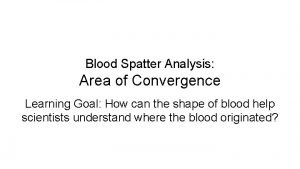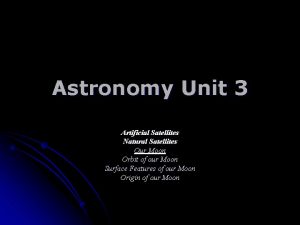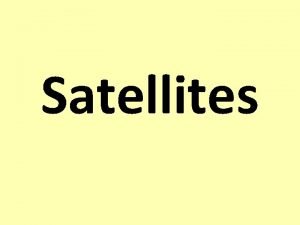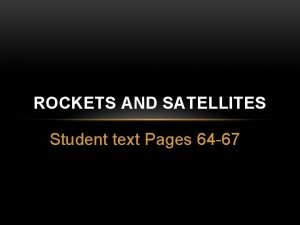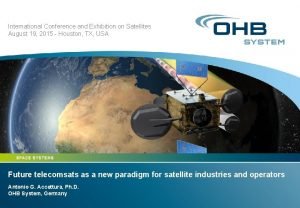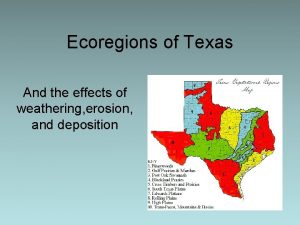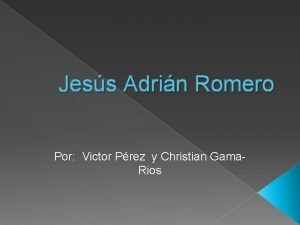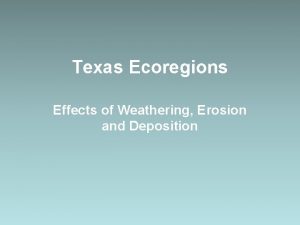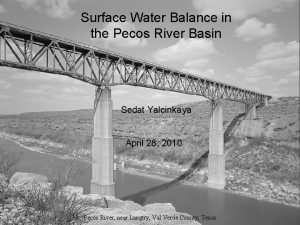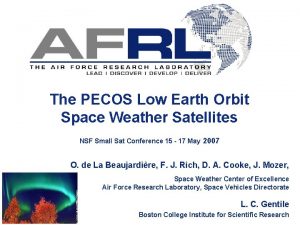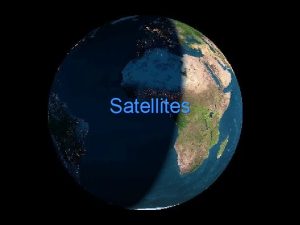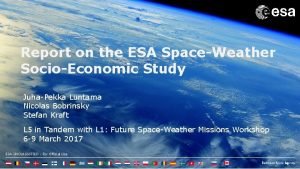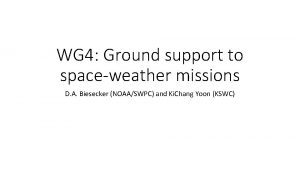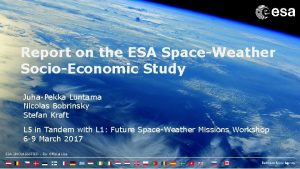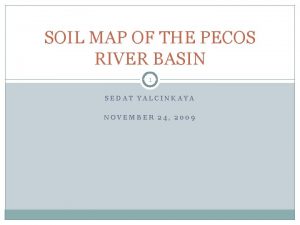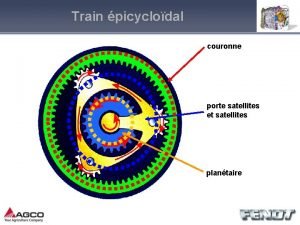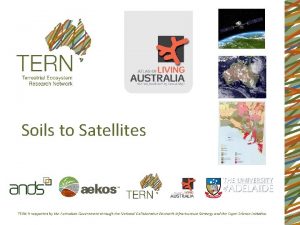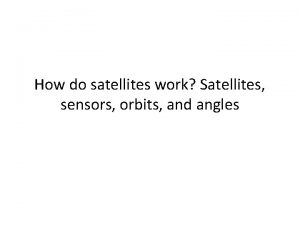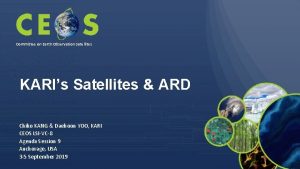The PECOS Mission of Small SpaceWeather Satellites in




























- Slides: 28

The PECOS Mission of Small Space-Weather Satellites in the Post DMSP Era Fifth Symposium on space Weather, Jan 22, 2008 O. de La Beaujardière, F. J. Rich, D. A. Cooke, J. Mozer, D. M. Ober, and C. Huang Space Weather Center of Excellence Air Force Research Laboratory, Space Vehicles Directorate L. C. Gentile Boston College Institute for Scientific Research

PECOS: Small LEO SWx Sats Overview • Introduction / rationale • DMSP / POES / NPOESS status • Proposed LEO constellations DMSP NPOESS – Polar and Equatorial Comm/nav Outage Satellites (PECOS) for SWx needs in ionosphere and neutral atmosphere – Architecture based on small satellites in 3 different types of orbits • Mission study and challenge to science community • Conclusion C/NOFS 2

Introduction • Looming crisis in U. S. space weather capabilities • Space Environment Sensor Suite (SESS) no longer on NPOESS • Last DMSP launch ~2012 • AF Space Command, SMC, AFRL and others developing comprehensive plan to specify and forecast natural space environment in post-DMSP era • Recommendation: PECOS (Polar & Equatorial Comm/nav Outage Satellites) small LEO satellites to meet ionosphere / thermosphere SWx requirements and ensure continuity of DMSP capability Actual Position Predicted Position 3

Rationale • Air Force is responsible for Do. D space weather • Understanding and forecasting space weather are key to ensuring SWx mission success • AF Space Command seeking funding in 2010 as ‘capability disconnect’ • Objectives of proposed PECOS mission – Nowcast and forecast of ionosphere and thermosphere conditions • Provide tools for Do. D and civilian systems for communication, navigation, surveillance • Coordinated effort by Do. D and civilian agencies to meet U. S. space weather requirements • Transition from DMSP era to 21 st century provides exciting opportunities for new technology development – Smaller satellites – Lighter payloads – Flexible launch options 4

PECOS Small Sats for SWx Polar Cap Scintillation Polar Ionospheric Disturbances AFSATCOM Mid-latitude Scint & TEC GPS Equatorial Ionospheric Disturbances Storm Effects Scintillation Forecasts Magnetic Equator Satellite Drag FLTSATCOM PECOS provides capability to specify and forecast ionospheric and thermospheric impacts on satellite systems. 5

Present Capability DMSP Orbits F 15, 2112 LTAN F 16, 2003 LTAN DMSP F 14, 1926 LTAN F 13, 1828 LTAN F 17, 1736 LTAN Primary 4 or 5 DMSP satellites on orbit at any time Back-Up LTAN = Local Time of Ascending Node @ Launch As of Feb 07 6

DMSP and POES Current SWx Sensors in Polar Orbit DMSP Block 5 D-3 (F 16 -20) TED DPU MEPED Space Environment Monitor (SEM-2) Magnetometer Thermal Plasma Sensor Auroral Particle Detector POES Ultraviolet Limb Imager Ultraviolet Disc Imager 7

PECOS A Proposed Solution for SWx PECOS is LEO mini-satellite constellations, 3 types of orbits • PECOS High -- Polar orbit, altitude ~ 800 km, sun synchronous • PECOS Low -- Polar orbit, low altitude • PECOS Equator -- Equatorial orbit, low altitude Objectives Large TEC plume disrupts nav, comm, and surveillance systems – Meet Do. D priority requirements in ionospheric density, scintillation, and satellite drag – Meet NPOESS IORD I space environment Environmental Data Records (EDRs) – Maintain current DMSP capability to ensure long-term continuity of space environmental monitoring – Leverage new technology development for future operational systems 8

PECOS High -1 • DMSP-type polar orbit: ~ 700 to 900 km altitude Nominal 2 or 3 -satellite constellation at ~ 14: 30, 20: 30, 00: 30 LT Objective: achieve DMSP functions Instruments: • • • – GUVI Mini-UV spectrograph / imager(s) • • – Electron density Neutral atmosphere composition (O/N 2) Auroral precipitation Equatorial scintillation Thermal plasma suite • • • Drift velocity, electric field Temperatures Ti, Te Electron density and density fluctuations 9

PECOS High - 2 • – – – Instruments (continued) • • • – – Magnetometer on short boom Currents Total electromagnetic energy Penetration electric fields Particle detectors 20 e. V - 10 Me. V for electrons 20 e. V - 300 Me. V for protons Scintillation (DORIS) and GPS receivers Electron density profile Scintillation, comm/nav outages Possible launch scenario: DORIS UHF/S-Band Beacons at Ground Sites 2 satellites on same rocket Desired LT orbits reached after time and altitude change Considering topside sounder on separate satellite 10

PECOS Low • Polar orbit – 2 sat constellation – • Circular (~300) or elliptical (~250 -1000 Km) Primary objective: – • Critical parameters for satellite drag Secondary objectives: – – • Electron density profile Scintillation Instruments – – • • • Neutral wind monitor Accelerometer ~12800 LEO objects in catalog Actual Position Predicted Position Thermospheric density Mass spectrometer Thermospheric composition Thermal plasma suite Drift velocity, electric field Temperatures Ti, Te Electron density and density fluctuations 11

PECOS Equator • Equatorial orbit – 2 sat constellation (~13° inclination) – • • – – – Circular (~300) or elliptical (~250 -1000 Km) Objective: Forecast low-latitude comm / nav outages C/NOFS follow-on Instruments • • • Thermal plasma suite Drift velocity Temperatures Ti, Te Electron density and density fluctuations Neutral wind monitor Planar Langmuir probe C/NOFS Electron density, in situ irregularities Scintillation (DORIS) and GPS receivers Electron density Scintillation, comm/nav outages Electric and magnetic field suite Electric field Wave spectra Plasma irregularities 12

Space Environment Monitoring Architecture Options Studies planned to optimize notional PECOS configuration – Constellation, orbit, payload (< 100 kg) – Improved instrument designs • Smaller in size, weight, power • Higher resolution measurements for more accurate specification • Operational systems must be based on proven technology • Need to demonstrate technology readiness – Standard small-sat bus and interface recommended for all PECOS spacecraft • AFRL Plug & Play satellites • Ball Aerospace SIV sats for STP • Other options – Adaptable launch configuration • ESPA ring • Minotaur, • Pegasus, etc 13

PECOS Proposed Design Study End-to-end assessment of requirements: from space environment parameters to mission application – – – Systematic analysis of requirements and options to meet them Operational analysis a critical component Interagency team Integrated approach leveraging data from other U. S. sources Determine best strategy for operational and S & T development • • Opportunity to demonstrate viability of new small-sat technologies Proven technology required for operational systems GUVI EPBs 14

Concluding Remarks • • AF is the responsible entity for Do. D Space Weather • Small sats solution provide opportunity to improve on DMSP capability PECOS small sat system will meet Do. D priority SWx requirements in ionosphere, scintillation and satellite drag – Possible architecture study needed • • • 2 or 3 sats on PECOS HI orbit (DMSP type) (primary for ionosphere, secondary for thermosphere) 2 sats on PECOS Low orbit (primary for thermosphere, secondary for ionosphere) 2 sat on PECOS equator (C/NOFS follow on) (primary for scintillation, secondary for iono and thermo) – – Mission development plan will define optimal configuration of orbits, instruments, models – Provides opportunity to revisit optimum configuration of sensors and address new needs Provides opportunity to leverage new technology development for sensors, spacecraft, launch options • Collaboration with NPOESS still needed • • Interagency coordination and collaboration are essential • If nothing is done soon, U. S. risks loss of capability to build and maintain space environment instruments – NPOESS ground segment will be a great asset Plan urgently needed to ensure continuity of SWx monitoring in post-DMSP era 15

Back-up Material Jicamarca Radar, Peru – Oct 22, 1996 GUVI DMSP C/NOFS 16

GPSOS Provides Accurate Profiles • Comparison with Jicamarca ISR electron density profiles • Figure shows JRO (dots), model with no data (dashed curve), with ground GPS data (solid blue curve), and with both ground and COSMIC GPS data. Vertical line represents Nm. F 2 derived from ionosonde • In this example, assimilation improves estimation of TEC and topside shape – but makes Nm. F 2 worse Addition of COSMIC data improves estimate of top-side shape

DMSP & PECOS Notional Timeline DMSP FY 07 FY 08 FY 09 FY 10 FY 11 FY 12 FY 13 FY 14 FY 15 FY 16 FY 17 FY 18 FY 19 FY 20 FY 21 F 13 F 14 F 15 F 16 F 17 F 18 F 19 F 20 C/NOFS PECOS C/NOFS Res. Ops Lab Dev / SPO PECOS-Eq-a PECOS-Hi-a PECOS-Lo-a PECOS-Eq-b PECOS-Hi-b PECOS-Lo-b Op S/C Extended-Op S/C Demo S/C SPO 18

NPOESS and PECOS • • Space Environment Sensor Suite (SESS) will not fly on NPOESS (outcome of Nunn-Mc. Curdy review) AF Space Command seeking funding in 2010 as ‘capability disconnect’ – • • Concerns with re-incorporating two sensors on NPOESS – Integration costs might not be borne by NPOESS IPO – NPOESS survival not assured – Does not meet SWx requirements and warfighter needs – Space weather is not prime concern for NPOESS Pre-Nunn-Mc. Curdy SESS did not meet Do. D SWx requirements – – – • 2130 orbit, required for ionospheric scintillation, eliminated Scintillation and magnetic field requirements not met Electron density profile and neutral density profile marginal Collaboration with NPOESS still needed – • PECOS small satellites would cost less than NPOESS SESS NPOESS ground segment will be a great asset PECOS mission maintains long-term continuity of space environment monitoring for Do. D SWx mission in post-DMSP era 19

Scintillation and Ionospheric Specification for Comm/Nav/Surveillance • Ionospheric density and irregularities affect Do. D SSA mission • Accurate forecast and specification of ionospheric parameters needed for: – – – Communication GPS Navigation Surveillance Geolocation HF communication Missile defense Scintillation Plasma Density AF Goal: 72 -120 hour space weather forecast 20

Satellite Drag and Precision Orbit Determination • Thermosphere (non-ionized part of upper atmosphere) affects satellite drag and reentry • Accurate nowcast and forecast of thermospheric parameters needed for: – – – Precise satellite orbit determination Avoidance of collisions with space debris Satellite reentry prediction Maintenance of space objects catalog (12800 objects) Prediction of satellite positions Actual Predicted Position Mission planning support • Design of space systems for long-term operations • End-of-life plans • Fuel and station-keeping – AFSPC Goal, 90 - 500 km: 5% drag error, 500 - 700 km: 10% error 21

Drivers for Satellite Drag/Neutral Density • Satellite drag is significant below 600 km • Thermospheric neutral density controlled by: Solar Wind Interaction • Solar EUV heating • Auroral heating (particles and electromagnetic energy) • Upward propagating waves from troposphere Density variability at 400 km • Solar cycle: factor of 10 variation with EUV over 11 yr cycle • Day-to-day: ~10% variability • Storm events: Factor of 6 increase in a few hours 22

Present Capability DMSP SWx Instruments and Measurements • Precipitating Particle Sensor (SSJ 5) – 30 e. V to 30 ke. V – Auroral Boundaries and Energy Deposition – Electron Density Profile • Thermal Plasma Monitor (SSIES) – In Situ Electric Field – In Situ Plasma Density and Temperature • Magnetometer (SSM) – In Situ Field-Aligned Current of Joule Heat Obs. – Global Geomagnetic Disturbance Proxy for Dst Index • Extreme Ultraviolet Scanners / Photometers (SSUSI and SSULI) – Plasma Density (~200 to 600 km) – Auroral Energy Deposition & Auroral Boundary – Neutral Atmosphere Density and Composition AFRL responsible for all DMSP SWx instruments, except SSULI 23

Present Capability DMSP Schedule • DMSP F 20 launch ~ 2012 FY 07 FY 08 FY 09 FY 10 FY 11 FY 12 FY 13 FY 14 FY 15 FY 16 FY 17 FY 18 F 15 F 16 Guaranteed Life Expected Life F 17 F 18 F 19 • • NPOESS: 2013 for C 1 launch Met. Op: A in 2006, B in 2010 (? ) F 20 FY 15 is critical time to have new operational system in place; program planning should start in FY 08 24

Complementary Space Instruments • Satellites / sensors presently on orbit – – – Met. Op with SEM particle detector JASON provides TEC above oceans DMSP SWx sensors (while it lasts) GRACE accelerometer CHAMP accelerometer (while it lasts) COSMIC DMSP • Planned satellite missions – NPOESS • Only SEM particle detectors (POES heritage) on one orbit – SWARM • 3 -satellite constellation for solid Earth magnetic field measurements, but no SSA contribution • Proposed Missions – UV Imager at GEO orbit – COSMIC II with GPS, mini-UV and DORIS Rx COSMIC 25

Complementary Ground-Based Instruments SCINDA Ground Stations (2008 plan) 30 N • SCINDA sites • Coherent radars 0 on a 24 / 7 basis 30 S • Ionosondes 60 E 90 E 120 E 150 E 210 E 240 E 270 E 300 E 330 E 0 30 E • All-sky cameras Backbone Sites Supporting Sites United Nations IHY Sites • GPS Rx DORIS UHF/S-Band Beacons at Ground Sites • DORIS Tx • Ground magnetometers • Fabry-Perot Interferometers • Incoherent Scatter Radars for campaigns 26

PECOS Development Issues • Important technology progress expected in spacecraft design, instrumentation, interface, launch options • Community input needed to assess – – – – – Spacecraft design / size Instrument miniaturization Standard interface options Optimum orbits Life time on orbit Launch options Telemetry / Real-time data need Software, models Impact on warfighter needs • Balance cost / schedule / performance / technical risk • SWx requirements tied directly to mission applications – Systematic analysis from SWx measurements to operations 27

GPSOS Provides Accurate Profiles • Comparison with Jicamarca ISR electron density profiles • Figure shows JRO (dots), model with no data (dashed curve), with ground GPS data (solid blue curve), and with both ground and COSMIC GPS data. Vertical line represents Nm. F 2 derived from ionosonde • In this example, assimilation improves estimation of TEC and topside shape – but makes Nm. F 2 worse Addition of COSMIC data improves estimate of top-side shape
 San diego sms satellites
San diego sms satellites Bromidification
Bromidification Solar power satellites and microwave power transmission
Solar power satellites and microwave power transmission Name of natural satellite
Name of natural satellite Uses of polar satellites
Uses of polar satellites Satellites in orbit around earth continually fall toward
Satellites in orbit around earth continually fall toward Exhibition for satellites
Exhibition for satellites South texas brush country weathering
South texas brush country weathering Pickleball popularity
Pickleball popularity Pecos romero edad
Pecos romero edad Weathering in edwards plateau
Weathering in edwards plateau Pecos wind power
Pecos wind power Trans pecos weathering
Trans pecos weathering Pecos river basin
Pecos river basin South texas plains weathering erosion and deposition
South texas plains weathering erosion and deposition đại từ thay thế
đại từ thay thế Vẽ hình chiếu vuông góc của vật thể sau
Vẽ hình chiếu vuông góc của vật thể sau ưu thế lai là gì
ưu thế lai là gì Công thức tiính động năng
Công thức tiính động năng Tỉ lệ cơ thể trẻ em
Tỉ lệ cơ thể trẻ em Vẽ hình chiếu đứng bằng cạnh của vật thể
Vẽ hình chiếu đứng bằng cạnh của vật thể Phản ứng thế ankan
Phản ứng thế ankan Quá trình desamine hóa có thể tạo ra
Quá trình desamine hóa có thể tạo ra Từ ngữ thể hiện lòng nhân hậu
Từ ngữ thể hiện lòng nhân hậu Tư thế ngồi viết
Tư thế ngồi viết Các môn thể thao bắt đầu bằng tiếng nhảy
Các môn thể thao bắt đầu bằng tiếng nhảy Hình ảnh bộ gõ cơ thể búng tay
Hình ảnh bộ gõ cơ thể búng tay điện thế nghỉ
điện thế nghỉ Thế nào là sự mỏi cơ
Thế nào là sự mỏi cơ

